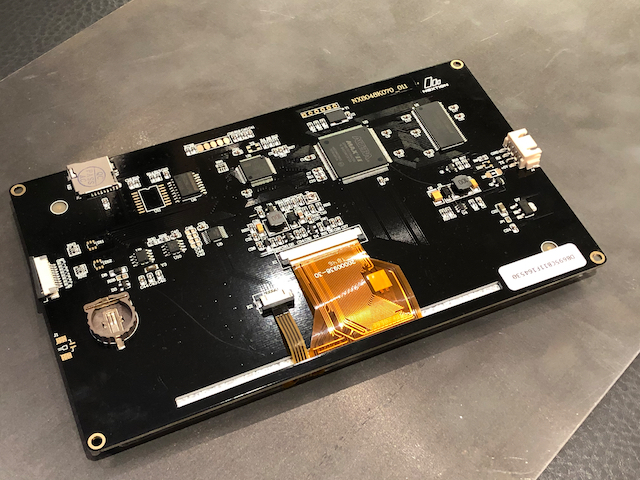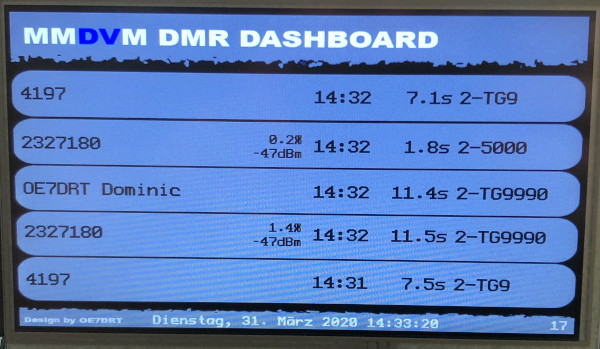My 7-Inch DMR Dashboard
Table of Contents
I got a Nextion NX8048K070_011 recently and I built a DMR Dashboard (again)
for this screen. You see the last five heard stations along with the timestamp
(hour, minute), the used timeslot and the used talkgroup. For your own
transmissions the RSSI information as well as the calculated BER will be
displayed.
Model and overview #
I’ve lost a few words about this topic (Nextion) in general on my first post about my 2.4 inch nextion screen in a previous article.

Have a look at the debug preview made within the Nextion Editor. The main screen is on the left and on the right side you see the system screen, this screen is for system tasks and you need a working NextionDriver installation to use all the buttons. Read more about the system screen on the chapter Management view.

I have not tested it yet with Pi-Star v4 but it should work as long as MMDVMHost
runs as root user. Otherwise you should download the HMI files and modify it
in your NextionEditor LTS.
The screen works fine on Pi-Star v4, but without NextionDrivers you won’t be able to use the start/stop buttons on the system page. In fact, you won’t be able to use any buttons that execute code on the linux box. Also the version and serial number does not get loaded without NextionDrivers.
Choose Nextion Layout L3 HS on Pi-Star – the screen runs with 115200 baud.
Get NextionDriver #
You may also find NextionDriverInstaller helpful.
Get the files (HMI and TFT) #
Download the files from my github repository.
Have a look at the releases tab as there are more older versions available (the older layout looks ugly on the system page, but has buttons for DMRGateway and DAPNETGateway).
Management view #
By “clicking” the page (mainly the header on the top of the screen) you will see a management screen with a lot of buttons. I think these are self-explanatory.
Although I hate to say it, but I had to run MMDVMHost as user root – otherwise the screen went all black. I’d rather like to have MMDVMHost running as a non-privileged user mmdvm. Please let me know if you found a solution to run MMDVMHost as user mmdvm again.
Maybe this is the reason why MMDVMHost runs as root on Pi-Star v4 too.
Above is a short demonstration of the system screen. The Layout might change
in the future, but you might edit the layout on your own. Just retext the
buttons and modify the executed command line.
At the moment the SHRINK LOGS button executes /usr/local/sbin/shrinklog
and the PHP-DASHBOARD ON and PHP-DASHBOARD OFF buttons execute
/usr/local/sbin/dashboard start and /usr/local/sbin/dashboard stop
respectively.
Most of the code in shrinklog has been taken from Pi-Star, which is why I
won’t release that file here, you gonna take the code from Pi-Star and modify
it to your needs. dashboard starts and stops php-fpm and places (or removes)
an index.html file in the webroot so it displays a message, that the dashboard
is offline. Otherwise nginx would display a simple Bad Gateway error message.
Pictures and images #
The dashboard looks something like this. On your own transmissions there is also RSSI and BER information available.

The duration of the transmission does not match with the duration on the web dashboard, but it gives a simple idea of its lenght. I’m not a good programmer so I’ll let this for now.